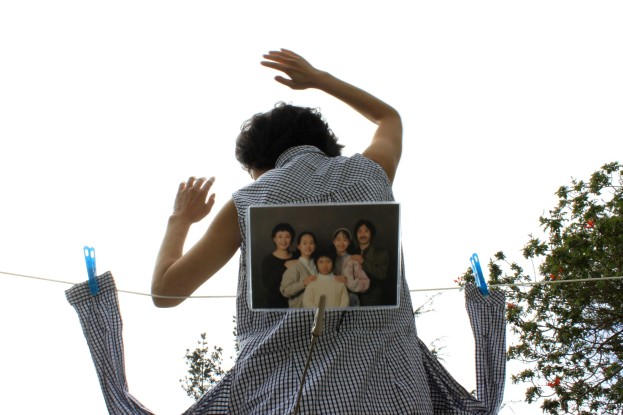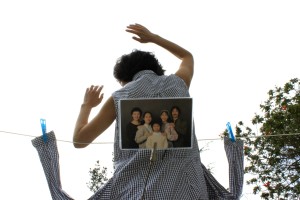
My work is greatly inspired and impacted by my family. Three years ago, my parents immigrated to the US from Japan to live with me and to continue pursuing their careers as visual artists in a new environment. It brought my curiosity to the relationship between family and work and how family influences the works artistically, economically, physically, and geographically. For my summer residency at Studio 210, I will collaborate with my parents to observe and explore the connections to family and how family has affected our works of art. At the end of the residency, we will present a trio performance as a work-in-progress.

Imprint and traces of Japan
I was born in Tokyo, Japan. I immigrated to the US when I was in my last year of junior high school and became a naturalized US citizen. Now, I don’t have the full sense of being American or Japanese. After living in the US for twenty-two years, I am becoming more conscious about how both my distance and connection to Japanese culture influences my identity and work.
My parents’ move to the US also created a stronger curiosity and immediacy to Japanese culture through my daily life in the US. At home, it began to feel like I was in Japan, speaking in Japanese, eating more Japanese food, and displaying Japanese mannerisms. Three years have passed since they moved, and the lines between what is Japanese and American become blurry.
In the past, my motivation to travel to Japan was merely to see my family. But now, my parents’ absence from Japan gives me a new perspective to visit Japan and cultivate my own process of intercultural and creative relationships.
My existence carries an echo of Japanese traditional culture and is impacted by the complex layers of different cultures. Contemporary society in the US carries such an echo and impact as well, in many fractured and complex ways that I wish to understand. This parallel and difference is an ongoing question.
My parent’s work
My father Hiroki Fukushima (born in Yamaguchi, Japan) is a metal artist who works primarily with iron, copper, and aluminum to create free-standing, hanging sculptures and functional objects (since 1972). In 2012, he moved to the United States with my mother to continue his artistic explorations. It was a challenge to leave his hometown at the age of sixty-four but he believes that to keep his motivation high, it is important to keep exposing himself to different environments. In Japan, he supported the family by undertaking architectural commissions for museums, temples, restaurants and residencies. Now, at the Crucible in Oakland, he is focusing on creating sculptural works, often with the theme of family.
My mother Michiko Fukushima (born in Tokyo, Japan) is a ceramist, visual artist, and teacher specializing in China painting and drawings. Her works often portray surreal scenes of botanical life and the mischievous play of children. She has been drawing since her childhood, and now in her late 60’s, she is currently exploring a mixed media approach of painting on unique surfaces, such as porcelain, plates and various objects. Additionally, her background in jewelry and doll-making has influenced her ongoing work in the fine arts. She currently works and teaches at the Crucible in Oakland.

As I was growing up, my parents often took my sister, brother, and me to museums and art exhibitions. I did not have much interest in art forms outside of dance but I would listen to their conversations about the arts with admiration and confusion. I didn’t know how to look at their art works but I had a sense of pride that they were artists. It was interesting for me to see them making works, being in the creative environment at their studios and checking their special tools for their craft. Witnessing my father’s extreme physicality and intensity working with metal left a strong impact and gave me a sense of an artist as a worker.
Beginning to dance
It was my mother’s wish to have her children take ballet lessons because when she was growing up, her family was poor and this made it difficult for her to study ballet. My older sister started taking ballet lessons when she was three years old. My mother would often carry me to the class to watch her dance. She took me to a ballet performance, Coppélia, performed by Morishita Ballet Company when I was three years old. When I turned six years old, my mother enrolled me into Tokyo Ballet School. I have been dancing since then and chose to create dance as my career.
Silence and families
For the collaborative project, Place for Family in Dance, I am especially drawn to exploring the existence of different silences that are unique to family connections. For example, the silence that exists within deeper connections between parents and children, and the silence that creates isolation, disconnection, and difficult unsaid areas.
For myself, silence is integral to looking at both family and dance. It is a key factor in finding the movements that communicate with people without words. In the past, my movements were greatly influenced by Western dance training in classical ballet and contemporary dance techniques that focus on the exterior beauty of lines and forms. Now, I am searching for the movements that connect to inner experiences and environments that are not just a mechanism or form.
Overall, I believe that the process of this work’s exploration will generate many shared questions and fruitful relations. It is my lifelong journey to keep searching for the way to listen and interact with the shifting existence of family and work.

Response to collaboration
In the beginning, I was not sure how my parents would respond to the idea of collaborating. I felt that it was complex to ask because collaborating might create too much pressure for them to try something new, while they’re currently still adjusting to the new environment with language and culture. I was surprised that their responses were genuinely excited and interested in a focused time to explore the concept of work and family together. The only concern for my mother was being unable to remember the choreography, and especially for my father, not forgetting what to do on stage. After our first conversation, my father shared his memory of doing Line Dance in elementary school and how difficult it was to remember the choreography. But he liked the dance because it was the only time a boy would be able to hold a girl’s hands in Japan. He briefly showed me the Line Dance from his memory.
This article appeared in the July/August 2015 issue of In Dance.


